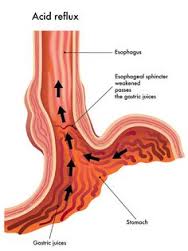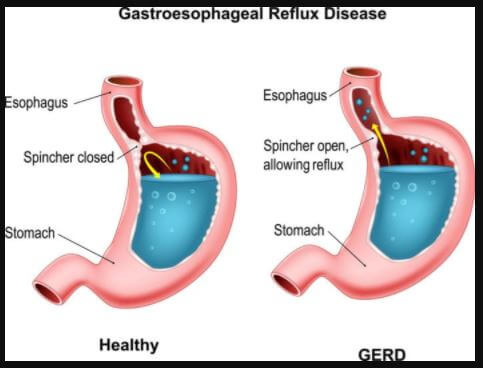What is Silent Reflux?
Silent reflux also known as Laryngopharyngeal reflux (LPR) is a condition in which the throat is discomforted by acid from the stomach.It is caused by a return or backward flow. In some instances the content of the stomach goes as far as the nasal passage. The acid flows into the throat/esophagus from the stomach causing the discomfort. It causes a state of coughing constantly and clearing of the throat. It can develop in both adults and children but luckily it is treatable.
If one suffers from this condition, they will not suffer in the same way a person with heartburn would and hence the reason it is referred to as silent. In gastroesophageal reflux disease(GERD) the heart burn is prominent and much easier to diagnose than LPR.1


Causes of Silent Reflux
When one eats food and digestion begins it travels from the mouth to the stomach through the esophagus. The digestion, absorption and finally extraction of waste then happens. Stomach acid may escape into the esophagus but your body is able to prevent this from happening.1,5
Each end of the esophagus has a muscle ring otherwise referred to as a sphincter. Theses muscles keep the stomach content in the stomach. But in situations where one has LPR the muscle rings do not work right hence causing the movement of these content to the throat and nasal areas. This flow of acid causes harm to areas where there is no protection from the acidity.
In infants however their entire body is underdeveloped and they are still slowly developing. This is why spitting up in infants is very common after feeding and they are full. Infants also lie down a lot and this can be another reason why the condition is a lot more likely to occur to them than to adults.
Certain people are more prone to this condition than others and these include people with conditions such as: a hiatal hernia, problem with lower food pipe valve, problem with food pipe contractions and a low-emptying stomach. Also if one uses their voice often such radio presenters, they are more at risk at experiencing this condition.
Symptoms of Silent Reflux

Babies exhibit symptoms such as3:
- The vomit may regurgitate down their chin or it may be projectile vomiting where it is forced out of their mouths or sometimes the nose and could hit a wall. The vomit may also appear like undigested food or digested food. It may contain other stomach content such as acid. It may contain bile or even sometimes blood. The amount varies but comes after eating and the occurrence is random and any place and on anyone or anything.
- In certain situations there is no vomit at all and the parent may hear the child’s reflux but not see and sign of it. In this case the baby may begin to cry during or after feeding out of nowhere or they may make a face.
- Feeding issues are also very common with children with the condition.
- Babies with silent flux may also have trouble falling asleep and staying asleep.
- Some babies might have varying weight gain. Most of the gain weight consistently however if the child is suffering from this condition it is likely that their weight gain will be affected.
Other symptoms in children may include3:
- Some of the signs may wear off with age but that might not necessarily mean that the condition is completely gone it may just mean that it has been changed
- Some report worsening of the situation with activities such as teething and crawling. Humid weather, coughing, laughing and running are some other activities that trigger the condition.
- The condition may go away for some time and then out of the blue reappear with no trigger whatsoever at times hence it is cyclic.
- When the child is able to sit and walk, the signs may lessen but when they crawl they may appear to worsen.
In adults however the symptoms may vary. The symptoms are as listed below1:
- Bitter taste at the back of the throat
- Breathing difficulties
- swelling and irritation of vocal chords
- Hoarseness
- Swallowing difficulties
- Sensation of something stuck in the throat
- Sensation of post nasal drip
- Hoarseness
- Frequent throat clearing
- Asthma
- Sore throat or burning sensation in the throat
- Persistent coughing
- A lump in the throat that does not go away with continued swallowing
Diagnosis of Silent Reflux
It is difficult to diagnose and may require a physical test and research into the medical history of the patient with one or two tests. The tests may include: pH monitoring where a small catheter is inserted through the nose and into the esophagus and throat. The sensors detect the acid in the throat and record findings over a period of 24 hours are taken by the computer worn around the waist. Also another test is, Endoscopic exam where a flexible or rigid instrument is used to view the throat and the vocal chords.5,1
Treatment
It can be treated in by:
- Medications are given by a professional.5
- Surgery may be done for abnormalities such as a sphincter that is malfunctioning.
The medication associated with the treatment of this condition include
- Prokinetic agents which increase movement of the gastrointestinal tract and increase the pressure of the lower esophageal sphincter. This is however not common.
- Antacids which neutralize acid and are used for aiding in heart burn.
- H2 blockers which reduce the gastric acid
- Sucralfate which protects injured mucous membrane
- Proton pump inhibitors which also reduce gastric acid.
Prevention
- If one is a smoker it is advised to quit smoking
- Sleeping with one’s head slightly elevated
- Losing excess weight if one is overweight
- Reducing alcohol consumption
- Eating meals and snacks 3 hours before going to bed
- Avoid foods that cause reflux4
Home Remedies
- Feeding smaller and more frequently
- Keeping the baby in vertical position for atleast 30minutes after feeding5
For adults
- Elevate the head of the bed 4-6 inches
- Restrict chocolate, mint, red wine and caffeine
- Refrain from putting on clothes that are tight fitting around the waist
- You may want to chew gum since it increases saliva and helps neutralize the stomach acid.
Complications
- Breathing problems like bronchitis and asthma
- Chocking episodes
- Sleep apnea
- Rarely can a patient have cancer of the esophagus, throat, lung, or voice box. For this to develop the condition must go untreated for very long.
- May affect the child’s growth rate
- It may cause deformed or malfunctioning esophageal sphincter and slow emptying of the stomach.2,4
References
- Silent Reflux – http://www.medicalnewstoday.com/articles/314531.php
- http://www.voiceinstituteofnewyork.com/silent-reflux-laryngopharyngeal-reflux-lpr-is-ubiquitous/
- http://www.reflux.org.au/information/common-characteristics-of-reflux/
- http://www.healthline.com/health/silent-reflux#outlook8
- Silent Reflux – http://www.webmd.com/heartburn-gerd/guide/laryngopharyngeal-reflux-silent-reflux#2
